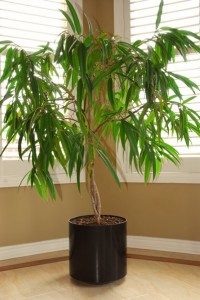Indoors


- Prune, repot and clean houseplants, as needed.
- Fertilize houseplants as new growth appears. Follow label directions.
- If not done already, sketch garden plans, including what to grow, spacing, arrangement and number of plants needed.
- Order seeds and plants as early as soon as possible.
- Place Easter lily, florist azalea, cyclamen and other seasonal flowering plants in bright, indirect sunlight. Keep soil moist.
- Pot up summer flowering bulbs to be transplanted outdoors later, including tuberous begonias, caladiums and cannas.
- Start seeds of warm-season plants, including tomatoes, peppers, eggplant, marigolds, zinnias and petunias for planting outdoors in mid-May.


General Landscape
- Fertilize woody plants before new growth begins.
- Complete pruning to remove dead and injured branches from trees and shrubs. Prune spring flowering shrubs, such as forsythia or lilacs, within a month after blooming.
- Mow grass as needed to 3 1/2- to 4-inches tall.
- Remove winter-damaged ground covers with trimmers or shears.
- Divide or transplant hardy perennials.
- Allow foliage of spring-flowering bulbs to ripen and turn yellow or brown or fall flat before cutting back. Leaves provide the food reserves stored in the bulbs that bring next year’s flowers. Divide or transplant spring-flowering bulbs after they’ve finished blooming. Mark empty spaces in the landscape to show where to plant spring-flowering bulbs next fall.
- Harden off transplants started indoors earlier by gradually exposing young plants to outdoor conditions of wind, sunlight and lower moisture.
- Remove winter covering from roses. Keep mulch nearby to use on plants in case of late freezes. Prune and fertilize as needed.
Vegetables and Fruits


- Sow seeds for cool-season crops, including peas, lettuce, spinach, carrots, beets, turnips, parsnips and Swiss chard, directly in the garden as soon as soil can be worked. Soil should crumble instead of forming a ball when squeezed.Mesclun seedlings can be transplanted outdoors anytime or the seeds can be sown directly in the garden. Photo courtesy National Garden Bureau
- Plant seedlings of cool-season crops, such as broccoli, cauliflower, cabbage, Brussels sprouts, kohlrabi and onions.
- Plant asparagus and rhubarb crowns. (Do not harvest until three years after planting.)
- Plant certified, disease-free potato sections or seed tubers.
- Plant strawberries, raspberries and other small fruit.
- Remove winter mulch from strawberries, but keep it handy in case late frosts threaten and to keep weeds down.
- Prune grape vines to remove dead or weakened limbs. Repair trellises as needed.
- Apply a pre-bloom, multipurpose orchard spray to fruit trees.


